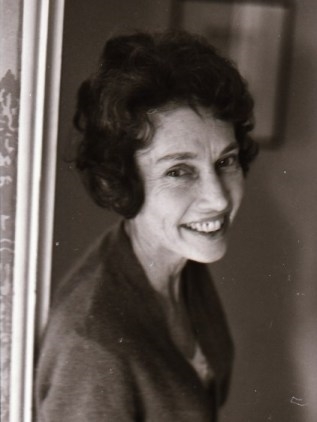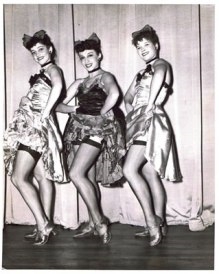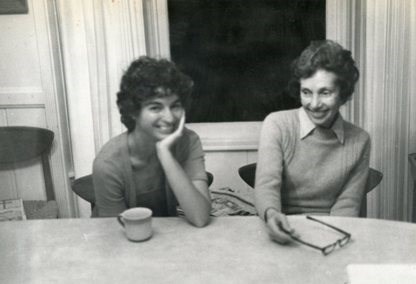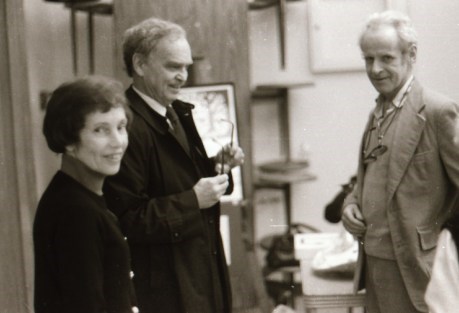 |
| Barbara Stuart (photo by Doug Miller) |
Barbara was more than a friend to our family. She was our guardian angel, as she was to so many other people in Laguna Beach. Always ready to help, yet always tactful, she supported the arts by personally helping the artists and musicians of the small town. If she had room in her big house, chances are it would be quickly and gratefully occupied by a creative, gifted individual who needed a place to call home.
Barbara loved all the arts and was a gifted "gatherer of people" in the old fashioned sense. A musical soiree or a dinner at Barbara's meant an engaging afternoon or evening of eccentric, intelligent, accomplished and down-to-earth people who always delighted in sharing their thoughts, stories, talents and passions around her piano or across her dinner table.
Artists and musicians were not the only people she helped. Her love for the unique beauty of her eccentric and beautiful town, Laguna Beach, created in her a protective love and care for its enduring open space with green hills all around...
Childhood
Growing up in Albany, New York, in the twenties and thirties, Barbara Stuart was a tomboy living in a time of straight-laced morality but with plenty of freedom to explore. She loved sports: sledding and ice skating, horseback riding, fishing, swimming and climbing trees. She adored nature and was always up for adventure.
Barbara was born April 10, 1916 to a prominent banking family. Her father, Charles Stuart, was in the ice and coal business in the days before powered refrigeration. During the winter, when the ice had frozen in the large reservoirs near the town, men would come out with saws to cut big blocks of ice. The blocks would be stored in ice houses outside town until needed by customers. Her mother, Margaret Walker Stuart (from a socially prominent family in Sarasota, Florida) selected Barbara's entertainment very carefully. Blue laws forbade the citizens from going to the movies on Sundays, but Barbara wasn't allowed to go to the movies anyway. Barbara said that her mother had even strongly advised her never to step foot in a grocery store!
Barbara had two siblings, an older sister named Betty and a younger brother named Walker. Barbara remained in close contact with Walker all her life. She remembers that Betty was very intelligent and that she had died when she was only thirteen from a medical condition that she had had since birth. The Stuarts' doctor, Dr. Shaw, was a good and plain man, according to Barbara. He drove an old beat-up car and came to their house when they were sick. Once, the doctor performed a small operation on Barbara's eye as she sat on the family couch. She had to be brave and not scream.
When she was eleven, she took her first long train ride from New York to Reno, Nevada. She fell in love with the West the moment she laid eyes on it and of course she went horseback riding every day.
Barbara decided early in her life that she wanted to be a dancer rather than go to college. The idea of a career in dancing was appalling to Barbara's mother; a career in dance was not considered respectable for nice girls. By the time that Barbara was old enough to go out into society, however, her mother had recently passed away. And although Barbara would forever honor and respect her mother (even displaying her mother's stern portrait over the couch in her living room), she was grateful that her stepfather (a Harvard educated attorney) gave her his blessing and assistance to pursue her dream - and later grew quite proud of her.
 |
| The Three Debs: Barbara, Lila and unknown dancer (balletpacifica) |
Dancing Days
Barbara first studied under Russian ballet instructors from Ballet Russe, whose names would be recognized by any ballet aficionado today: Pierre Vladimiroff, Anatole Vilzak and, her favorite, George Ballanchine. Barbara said that Ballanchine was her favorite because he never raised his voice, merely twitched his nose instead. She was grateful for his patience.
Barbara's first paying job was at the Guild Theatre in New York with Agnes de Mille. She was thrilled to receive $10 for her work. She could not believe her good fortune to actually be paid for what she loved doing. Barbara then joined the American Ballet which later became the New York City Ballet.
Barbara had vivid memories of a stint performing at the Radio City Music Hall with a small ballet company for two shows a day, 7 days a week! Remember that this was in the days of no air conditioning. Barbara said that the rehearsals during those New York summers were quite an ordeal.
Next she studied with Vacheslav Swoboda and it was there that she would meet someone who was to become a life-long friend and partner - a Russian immigrant and talented ballerina named Lila Zali. Lila had danced in Colonel de Basil's Ballets Russes and was eager to put her energy and talent to work at starting her own company, which she called Le Petite Ballets Russes, and which toured Canada.
World War II intervened and for Barbara it began as she was walking down a New York City street one day. The loudspeaker (which at that time announced the news of the day) blared: "Pearl Harbor! War is declared!" And then President Roosevelt's voice could be heard explaining what had happened. Barbara said that everyone felt paralyzed and wondered what they could do to help.
This set her on a whirlwind tour as part of the USO, in a little group that Lila had formed called The Three Debs. The group included Lila, Barbara and another dancer. They toured the United States by train in the U.S.O.'s own attached train cars. She met many wonderful people on these trips. Later, the group toured the South Pacific with Jack Paar as the U.S.O.'s Master of Ceremonies.
In Europe, as the war drew to a close, they traveled in a troop convoy and performed as dancers in the opera "Die Fledermaus". They performed in many bombed-out cities, but their accommodations were comfortable. Barbara remembered one young dancer saying in surprise, "But I thought we were supposed to suffer!"
Bringing Music and Dance to Southern Orange County
After the war, Barbara and her friend, Betsy, decided to Go West and strike out for the coast of California to visit Lila and her new husband, Kolia, in Los Angeles. Nicolas (Kolia) Levienne was a prominent cellist who had played for Anna Pavlova in Russia. Kolia and his brother Mischa had barely escaped Russia before the fall of the Iron Curtain. Through Lila, Barbara met Kolia's friend, Max Rabinowitsh (who had also fled Russia). Max had been a former pianist and accompanist to the famed Russian opera singer Feodor Chaliapin. He had also accompanied famed dancer Isadora Duncan (the "mother of modern dance") and was now a successful Hollywood studio musician.
Max and Barbara married in 1947. During that year, the two couples formed a small touring company that they called Ballet Musicale and had great fun as they traveled throughout California for a year. The husbands played music and the wives danced. In 1948, Barbara settled into semi-retirement as she devoted herself to motherhood to the first of her two sons - although she didn't give up her classes entirely.
History had taken another turn when Lila and Kolia had invited Max and Barbara to vacation at their second home in Laguna Beach. Barbara fell in love with the town and the family moved there in 1959. Kolia and Mischa Levienne and Lila had been working to provide Laguna and the surrounding area with what became known as the Laguna Beach Chamber Orchestra Society. The Chamber Orchestra invited guest musicians from all over the world to stop by on their tours through Los Angeles to come perform in the high school theater of the little town.
 |
| Ballet Pacifica's Sleeping Beauty. Barbara plays the queen (Photo by Doug Miller) |
Lila and Kolia's home in the south part of town was adjacent to a building on Coast Highway that was large enough for a ballet studio. Lila established the Laguna Beach Civic Ballet - later to be renamed Ballet Pacifica and began giving ballet classes there. She invited Barbara, and later others, to help make the company grow.
And that wasn't all. They also established a ballet company for the town. Barbara taught classes to the youngest dance students and also stepped up to become the chairwoman of Ballet Pacifica's board of directors and of the development committee. She took care of the books and documents so that Lila could concentrate of her art and teaching. Lila served as the company's director, choreographer and seamstress and she was a formidably persuasive advocate for ballet.
Against so many odds, and principally because of Lila's passion and drive and with the help of her devoted followers, Ballet Pacific performed high quality shows for many years. On the occasion of its 25th Anniversary, the company was honored by President Ronald Reagan, then the governor of California, and Gene Kelly (Lila had performed with him in the film American in Paris). But sadly, some good things will come to an end. Ballet companies are notorious for having to struggle for funding. It is an art form that has a small base of passionate fans but not enough to keep it going without struggle. It is to Laguna Beach's credit and Lila's zeal that it lasted as long as it did.
After Lila's retirement and then her death in 2003, the company went through several metamorphoses. Unfortunately, without Lila's guiding spirit and the teamwork she had inspired, the engine of the company slowly began to fail. In 2007, after several new directors and because of funding problems, Ballet Pacifica was no longer in existence as we had known it.
Barbara's Legacy in the Laguna Green Belt
Barbara's love was not only for the arts and culture. She was also actively engaged in and generous to the community in other ways - Soroptimists, St. Mary's Episcopal Church - but most especially with the founding of the Laguna Greenbelt. Barbara was a board member for many years and a close friend of Jim Dilley's. Many of the early board meetings, planning sessions and social occasions took place around Barbara's table.
It is a lesson in life to understand how one person's vision, talent and drive can inspire so many others to join in to make a difference. We can see this in numerous ways throughout history and in our own everyday lives. Sometimes the work will last only as long as the person who dreamed it can keep it going, and for as long as the memories last.
Sometimes it will last for much longer because so many others remain invested in it.
This passion and vision can still be seen in Jim Dilley's dream to make a greenbelt around Laguna Beach. And Barbara was a part of that, too.
Barbara's gift to everyone was her quiet work in assisting in every way she could. As with many community-minded people, she always downplayed her part, but there was so much that would not have happened without her devotion and energy. And that is a valuable lesson for all of us, too.
After Barbara passed away in her beloved Laguna Beach on June 25, 1998, it was discovered that a large amount had been quietly bequeathed by her for the preservation of the Laguna Greenbelt so that others could enjoy its beauty for years to come.
 |
| Barbara's Lake (http://www.caopenspace.org/barbaraslake.html) |
In honor of Barbara, the Greenbelt expressed its appreciation by naming the little lake after her:
"Barbara's Lake is Orange County's only natural lake. The 6-acre lake is located in the Jim Dilley Preserve and the lake is fed by a series of natural springs and is named for long-time Laguna Greenbelt board member and open space advocate, Barbara Stuart." (www.lagunagreenbelt.org)

Becky and Barbara 1977 (Photo by Doug Miller)
Barbara was more than a friend to me. She was a second mother to my husband, Doug, godmother to our two sons, and an inspiration to our family in so many ways. I miss her honesty, her curiosity, her optimism and her kindness. I will always miss her.
 |
| Barbara, Jim Dilley and Barbara's brother Walker Stuart 1977 (Photo by Doug Miller) |
I know that among Barbara's many heroes would be her brother, Walker Stuart. She was proud of Walker's contributions as one of the producers of the Disney film Never Cry Wolf. Walker even played a small acting role on location in the Arctic Circle.
Clip of the movie with music by Mark Isham
Page created on 7/31/2014 6:45:50 PM
Last edited 4/8/2020 11:59:29 PM
Miller, Jesse. "Barbara Stuart. "Interview . 1995.
Kahn, Kathy. "Barbara Stuart. "
